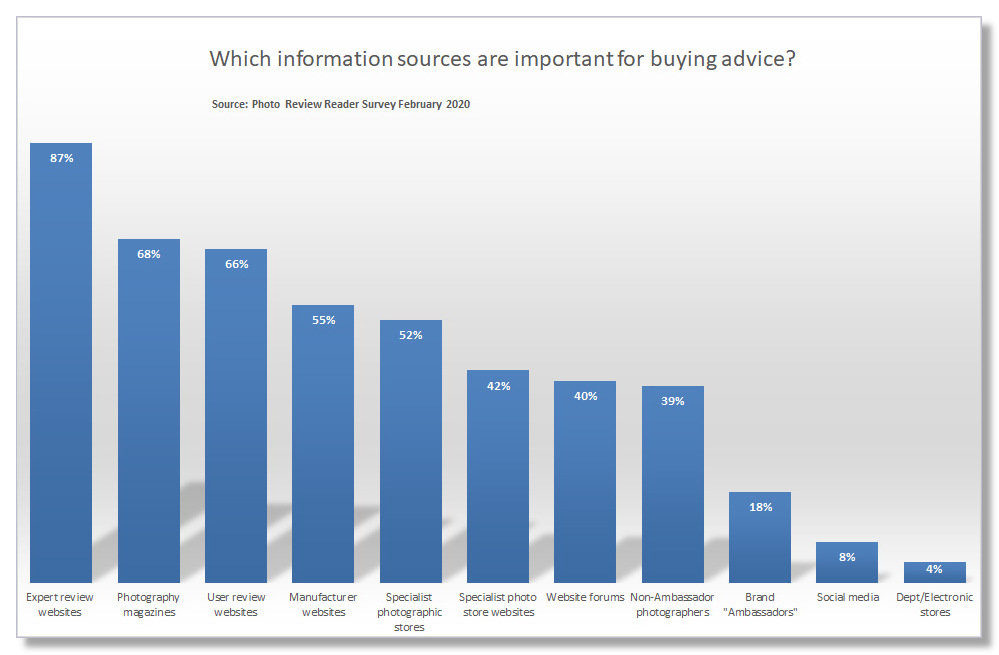While the latest CIPA figures and the impacts of the coronavirus cast a bit of a pall over the photo industry, it’s not all gloom and doom! The results from Photo Review‘s 2020 Reader Survey has painted a positive picture regarding future purchasing trends and photo printing from the key demographics of enthusiasts, and professional and semi-professional photographers.

The publishers of the Photo Review magazine and website conduct a survey of subscribers each year, providing the local industry with some rare ‘hard data’ on buying intentions and trusted sources of information.
According to the survey – which is always well-supported by readers, delivering a sample size which gives the results statistical validity – 97 percent of respondents plan to buy a new mirrorless or DSLR camera in the next two years, while 81 percent plan to buy a lens. While this is actually a slight drop from the 2019 survey (perhaps some of those surveyed in 2019 have already made their purchase!) it remains a significant jump on 2018 figures and challenges the gloomy market sentiment.
There has been a marked rise in buying interest for mirrorless cameras, from just above 35 percent to 49 percent over the past two years. Corresponding with this, there’s been a drop in DSLR buying plans, from around 38 percent to 28 percent.
The stats showing a shift in interest from DSLR to mirrorless is in line with the increase in desirable mirrorless full-frame camera releases from a range of manufacturers over the past 12 months. This final step in the journey from all-analog to all-digital cameras may also have had a part to play in photographers deciding it was time for a camera upgrade.
But mirrorless hasn’t killed the DSLR yet, with just a single percentage point leaving the DSLR the chosen tool for photography over mirrorless – 76 percent of respondents either regularly or occasionally use a camera with mirrors, compared with 75 percent without.
Good news for photo retailers is that survey respondents are buying their gear from the trusted local specialist in good numbers, with 30.5 percent ‘always’ and 40.5 percent ‘regularly’ visiting the local camera shop for purchases. Only 3.6 percent ‘never’ visit the specialists. These figures are way in front of the other options, with online stores outside Australia way down the list.
While 24.8 percent regularly buy from an Australian online webstore (with only four percent ‘always’ buying from them), literally zero percent ‘always’ hit up the overseas online sellers, and just 11.5 percent ‘regularly’ do. Beyond Photo Review readers being great supporters of local business, whenever Inside Imaging has crunched the numbers to compare overseas and local pricing, the locals are often cheaper, especially when freight charges are included. Then there’s other benefits like warranty, service, and speed of delivery.
Print isn’t dead
A whopping 94 percent of respondents print (at least some of) their photos, with 62 percent planning to print photos larger than 5×7 this year. However most of this printing, 54 percent, will take place at home, while 38 percent will visit a prolab. The next most popular printing method is the kiosk, at 22 percent.
After large prints, the photo book is the next most popular printed product, with 49 percent of respondents planning to make one this year. Interestingly, 38 percent plan to buy a printer in the next two years, and 85 percent of readers want more print reviews. So the interest in hard copy is alive and well!
Who do you trust?
While there may be some intrinsic bias in a survey of Photo Review readers, 87 percent find expert review websites the most important information resource for buying advice. This is followed by a near-tie between photography magazines at 68 percent, and user review websites at 66 percent.

These three sources mostly offer ‘authentic’ information – they are valid third party sources, rather than a direct arm of the camera distributors’ marketing machines. On the other hand some review websites (mainly overseas-based) rely on partner links to webstores to earn a commission, and one of the majors, DPReview – is actually owned by Amazon.
Specialist photographic stores are considered trustworthy among 52 percent of readers, while their websites are also rated highly as important sources of information.
Given the obsession with ‘social media’ as a source of information, it’s perhaps surprising that only 40 percent consider website forums important for buying advice.
While camera companies seem to be sinking a significant proportion of their marketing budgets into social media and brand ambassadors, they are the least important information sources for buying advice, according to the survey. Only 18 percent of respondents feel ambassadors are important, and just eight percent rely on social media.
Inside Imaging‘s current Readers’ Poll asks a similar question: Do you think the camera and lens companies’ multiple Ambassador programs are cutting through with potential camera buyers? The response is similar – 55 percent said ‘no’, 27 percent said ‘occasionally’, and just 11 percent said ‘yes’.’
This likely comes back to the issue of authenticity. Brand ambassadors, social media influencers – whatever they identify themselves as – everyone now knows who they are, what they’re doing and that their relationship to the brand is at its base transactional. Even though they genuinely endorse the product in good faith, there seems to be a growing perception that this marketing approach is inauthentic.
When photographers who aren’t brand ambassadors have over twice the credibility as photographers who are brand ambassadors (39 percent versus 18 percent), you kind of know they are past their use-by date as product endorsees.





Be First to Comment